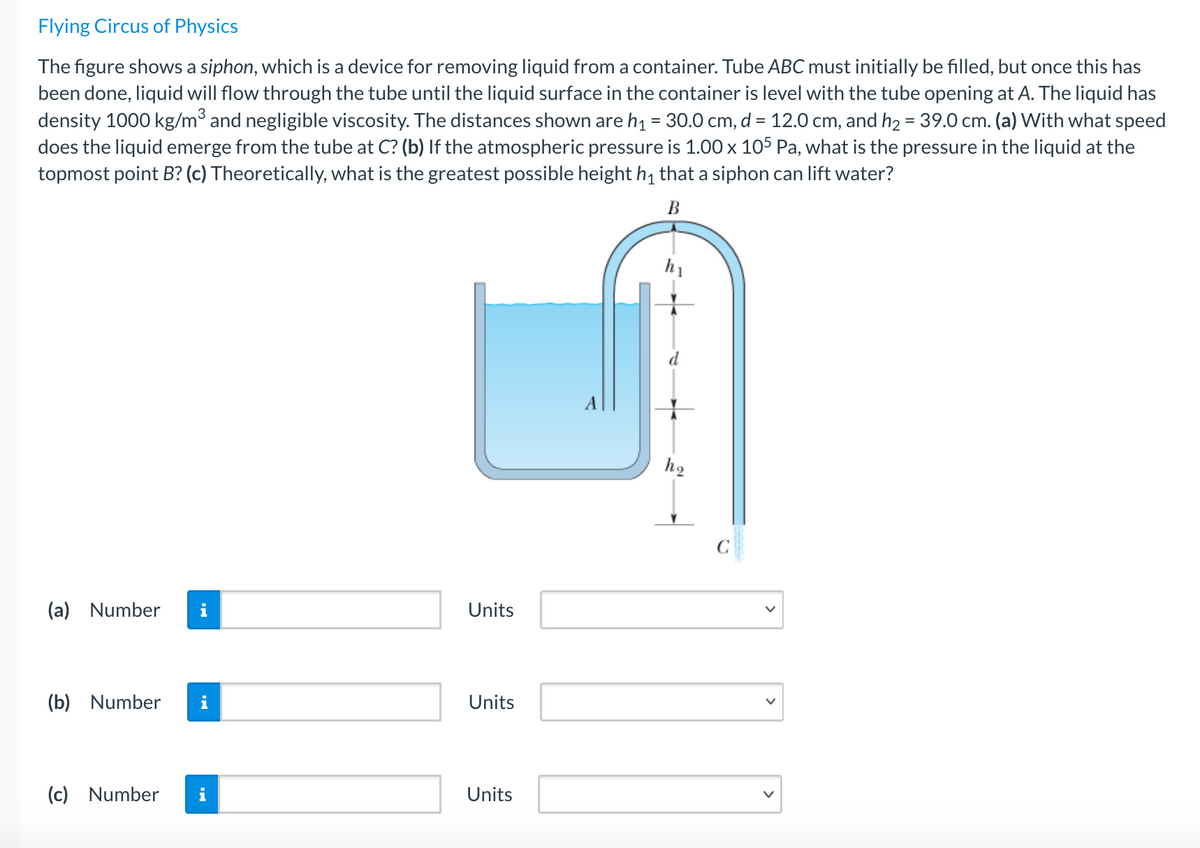The figure shows a siphon, which is a device for removing liquid from a container. Tube ABC must initially be filled, but once this has been done, liquid will flow through the tube until the liquid surface in the container is level with the tube opening at A. The liquid has density 1000 kg/m³ and negligible viscosity. The distances shown are h1 = 30.0 cm, d = 12.0 cm, and h2 = 39.0 cm. (a) With what speed does the liquid emerge from the tube at C? (b) If the atmospheric pressure is 1.00 x 105 Pa, what is the pressure in the liquid at the topmost point B? (c) Theoretically, what is the greatest possible height h that a siphon can lift water? В d C
The figure shows a siphon, which is a device for removing liquid from a container. Tube ABC must initially be filled, but once this has been done, liquid will flow through the tube until the liquid surface in the container is level with the tube opening at A. The liquid has density 1000 kg/m³ and negligible viscosity. The distances shown are h1 = 30.0 cm, d = 12.0 cm, and h2 = 39.0 cm. (a) With what speed does the liquid emerge from the tube at C? (b) If the atmospheric pressure is 1.00 x 105 Pa, what is the pressure in the liquid at the topmost point B? (c) Theoretically, what is the greatest possible height h that a siphon can lift water? В d C
Principles of Physics: A Calculus-Based Text
5th Edition
ISBN:9781133104261
Author:Raymond A. Serway, John W. Jewett
Publisher:Raymond A. Serway, John W. Jewett
Chapter15: Fluid Mechanics
Section: Chapter Questions
Problem 69P
Related questions
Question

Transcribed Image Text:Flying Circus of Physics
The figure shows a siphon, which is a device for removing liquid from a container. Tube ABC must initially be filled, but once this has
been done, liquid will flow through the tube until the liquid surface in the container is level with the tube opening at A. The liquid has
density 1000 kg/m³ and negligible viscosity. The distances shown are h1 = 30.0 cm, d = 12.0 cm, and h2 = 39.0 cm. (a) With what speed
does the liquid emerge from the tube at C? (b) If the atmospheric pressure is 1.00 x 105 Pa, what is the pressure in the liquid at the
topmost point B? (c) Theoretically, what is the greatest possible height hị that a siphon can lift water?
%3D
В
h1
A
h2
C
Number
i
Units
(b) Number
i
Units
(c) Number
Units
>
Expert Solution
This question has been solved!
Explore an expertly crafted, step-by-step solution for a thorough understanding of key concepts.
This is a popular solution!
Trending now
This is a popular solution!
Step by step
Solved in 2 steps

Knowledge Booster
Learn more about
Need a deep-dive on the concept behind this application? Look no further. Learn more about this topic, physics and related others by exploring similar questions and additional content below.Recommended textbooks for you

Principles of Physics: A Calculus-Based Text
Physics
ISBN:
9781133104261
Author:
Raymond A. Serway, John W. Jewett
Publisher:
Cengage Learning

University Physics Volume 1
Physics
ISBN:
9781938168277
Author:
William Moebs, Samuel J. Ling, Jeff Sanny
Publisher:
OpenStax - Rice University

College Physics
Physics
ISBN:
9781305952300
Author:
Raymond A. Serway, Chris Vuille
Publisher:
Cengage Learning

Principles of Physics: A Calculus-Based Text
Physics
ISBN:
9781133104261
Author:
Raymond A. Serway, John W. Jewett
Publisher:
Cengage Learning

University Physics Volume 1
Physics
ISBN:
9781938168277
Author:
William Moebs, Samuel J. Ling, Jeff Sanny
Publisher:
OpenStax - Rice University

College Physics
Physics
ISBN:
9781305952300
Author:
Raymond A. Serway, Chris Vuille
Publisher:
Cengage Learning

College Physics
Physics
ISBN:
9781938168000
Author:
Paul Peter Urone, Roger Hinrichs
Publisher:
OpenStax College

Physics for Scientists and Engineers, Technology …
Physics
ISBN:
9781305116399
Author:
Raymond A. Serway, John W. Jewett
Publisher:
Cengage Learning

Physics for Scientists and Engineers: Foundations…
Physics
ISBN:
9781133939146
Author:
Katz, Debora M.
Publisher:
Cengage Learning